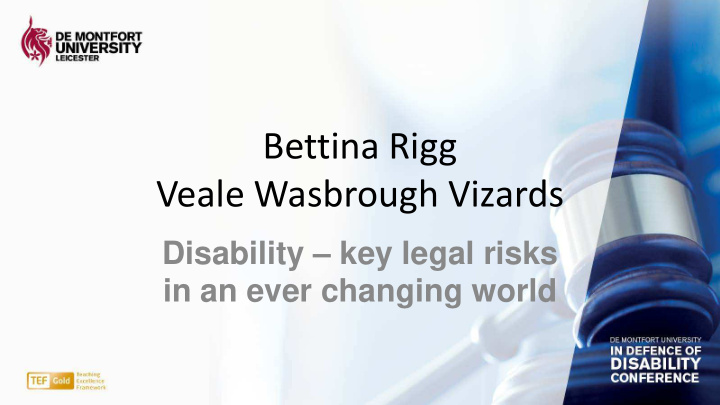



Bettina Rigg Veale Wasbrough Vizards Disability – key legal risks in an ever changing world
1. The starting point • The Public Sector Equality Duty and the Equality Act 2010 • Risks identified and managed at local level • BUT the world has changed!
2. Some key changes • Changes to DSAs • The Office for Students • The TEF • Consumer legislation • GDPR
3. Changes to DSAs • “We will look to HEIs to play their role in supporting students with mild difficulties, as part of their duties to provide reasonable adjustments under the Equality Act. These are partly anticipatory duties and we expect HEIs to introduce changes which can further reduce reliance on DSAs and help mainstream support.”
4. Changes to DSAs – key risks • HE providers not fully understanding the Equality Act 2010 duty to make reasonable adjustments and what it means in practice • Failing to comply with the anticipatory duty • Failing to comply with the public sector equality duty
5. The Office for Students • Working for positive outcomes for students from all backgrounds • The four regulatory objectives • Risk of Access and Participation Plan not being approved and impact on OfS registration • Risk of student complaints about quality and standards and impact on OfS registration
6. The TEF • Quality – learning environment, student outcomes and teaching quality • Flags and split metrics • The relevance of the need for teaching to be accessible to disabled students
7. Consumer legislation • The requirements of consumer protection law apply to the relationship between HE providers and their students • Accurate and unambiguous information • Don’t over promise!
8. GDPR • Greater obligations • Greater financial and reputational risks • The benefits of inclusive teaching and learning as opposed to individual support
9. Conclusion • Accessibility for disabled students needs to be at strategic and institutional level • Less focus on ad hoc/individual support • The importance of disability services to strategic planning
Recommend
More recommend